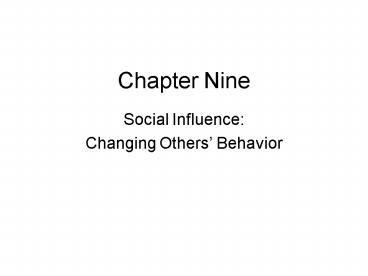Chapter Nine - PowerPoint PPT Presentation
1 / 24
Title:
Chapter Nine
Description:
Door-in-the-face 'That's not all' Playing hard to get. Deadline. Complaining ... Door-in-the-Face Technique ... Example: smiley faces. Obedience ... – PowerPoint PPT presentation
Number of Views:85
Avg rating:3.0/5.0
Title: Chapter Nine
1
Chapter Nine
- Social Influence
- Changing Others Behavior
2
Social Influence
- Efforts by one or more individuals to change
attitudes, belief, perceptions, or behaviors of
one or more others.
3
Conformity
- A type of social influence in which individuals
change their attitudes or behavior in order to
adhere to existing social norms.
4
Social Norms
- Rules indicating how individuals are expected to
behave in specific situations - Implicit
- Explicit
5
Factors Affecting Conformity
- Cohesiveness
- Group size
- Type of social norm
6
The Bases of Conformity (Why do we choose to go
along?)
- Desire to be liked
- Normative social influence Social influence
based on individuals desire to be liked or
accepted by other persons. - Desire to be right
- Informational social influence Social influence
based on individuals desire to be correct to
possess accurate perceptions of the social world.
7
Justifying Conformity
- Cognitive consequences of going along with the
group - Those that conform easily those that dont
8
Why We May Choose to Not Go Along
- Need to maintain our individuality
- Individuation The need to be distinguishable
from others in some respects - Line experiment and collectivist versus
individualistic cultures - Need to maintain control over our own lives
9
Minority Influence
- Can minorities change the position of majority?
- Conditions
- Consistency
- Avoid appearing rigid
- Social context
- How do they get their message across?
- Systematic processing
10
Compliance
- Underlying principles of Compliance
- Caldini
- Friendship/Liking
- Commitment/Consistency
- Scarcity
- Reciprocity
- Social Validation
- Authority
11
Techniques for Compliance
- Ingratiation
- Foot-in-the-door
- Low-ball
- Door-in-the-face
- Thats not all
- Playing hard to get
- Deadline
- Complaining
- Putting others in a good mood
12
Ingratiation
- Impression management
- Ingratiation A technique for gaining compliance
in which requesters first induce target persons
to like them, then attempt to change their
behavior in some desirable manner. - Techniques
13
Foot-in-the-Door Technique
- A procedure for gaining compliance in which
requesters begin with a small request and then,
when this is granted, escalate to a larger one
(the one they desired all along). - Based on commitment/consistency
14
Low-Ball Procedure
- A technique for gaining compliance in which an
offer or deal is changed (made less attractive)
after the person has accepted it. - Auto sales
- Commitment/consistency
15
Door-in-the-Face Technique
- A procedure for gaining compliance in which
requesters begin with a large request and then,
when this is refused, retreat to a smaller one)
the one they actually desired all along). - Based on reciprocity.
16
Thats not all Technique
- Here an initial request is followed by something
that sweetens the deal (before they say yes or
no). - Based on reciprocity
17
Playing Hard to Get
- Suggesting that a person, object, or outcome is
scarce and hard to obtain. - Tactic bases on scarcity
18
Deadline Technique
- Persons are told that they have only limited time
to take advantage of some offer or to obtain some
item. - Tactic based on scarcity
19
Complaining
- Expressing discontent, dissatisfaction,
resentment, or regret may be used as a means of
exerting social influence on others.
20
Putting Others in a Good Mood
- Related to ingratiation
- Example smiley faces
21
Obedience
- Obedience when someone in a position of
authority simply tells or orders one or more
other persons to do something and they do it. - Presentation
- Milgram
22
Destructive Obedience
- Why does it occur?
- Transfer of responsibility
- Obvious reminders of authority
- Escalation of orders
- Events move quickly
23
Resisting the Effects of Destructive Obedience
- Remind individuals that they can be held
responsible. - Clear indication of what is too far
- Question the expertise and motives of the
authority figure - Just knowing about the power of authority
- Summary
24
Individual Difference and theUse of Social
Influence
- Yes
- Caldwell and Berger (1997)
- Success and individual differences

